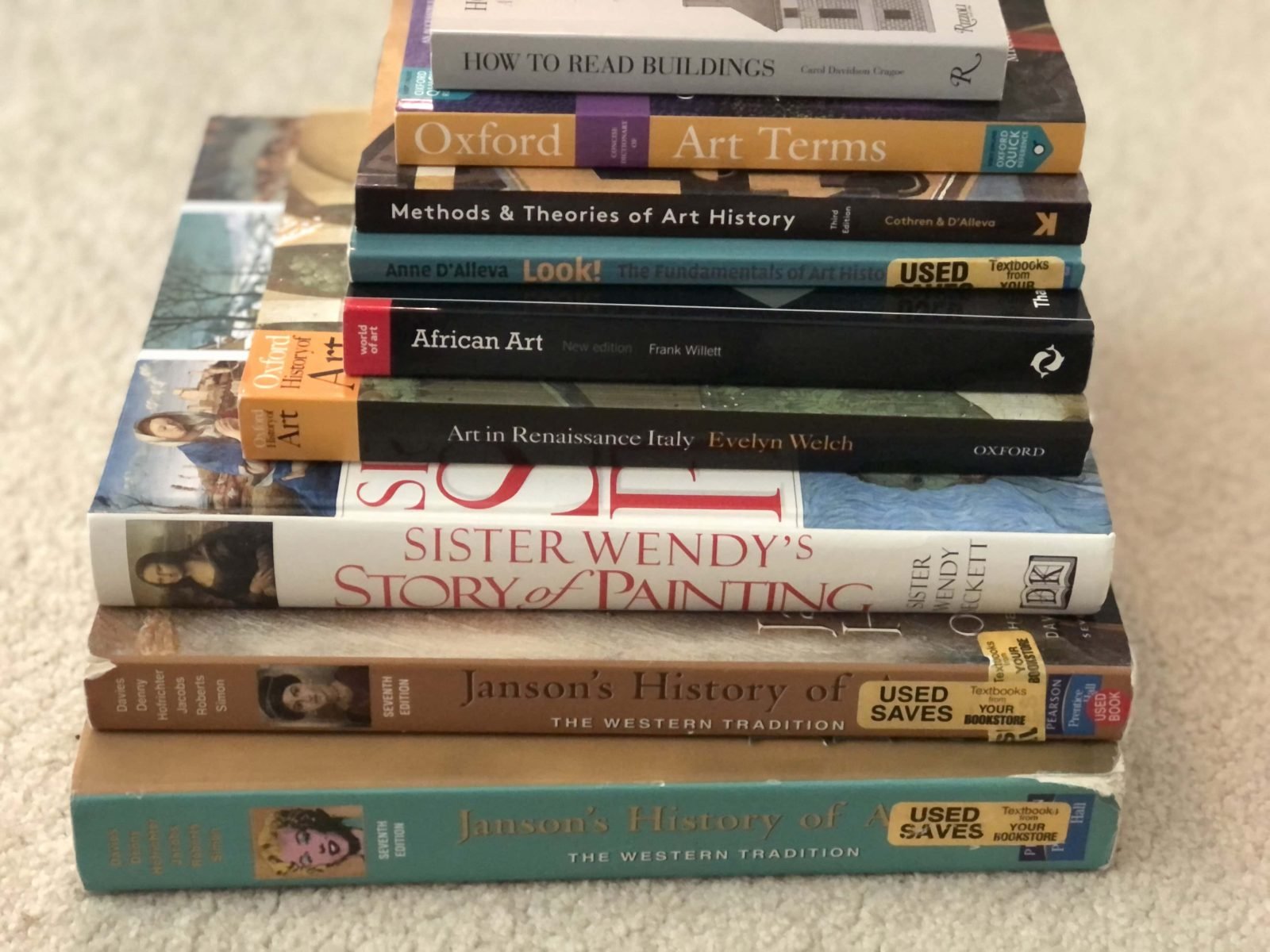Are you looking for some reading material to start or further your art history adventure? Here are my recommendations for the best books (and some online alternatives) to help you along the way, from survey texts and books for beginners to reference material and more.
Survey texts
Survey texts cover large areas of art history in broad strokes by focusing on a handful of key artworks and buildings in each period. These are the textbooks used in introductory art history courses. Janson’s History of Art, the Western Tradition, a two-volume set, was long the gold standard, and it was used in my college survey classes. I believe that the reissued eighth edition is the newest.
However, there’s now a great alternative – SmartHistory, a free website produced and written by art history professors. It’s basically a survey book in website form, only it has a much broader selection of topics, particularly outside the traditional canon of white male Europeans that Janson largely limits itself to. Plus, it is always adding new text and video content. Some professors use it in place of a physical textbook now, and there’s no reason you shouldn’t too. I rarely pick up my Janson books anymore, but I do reference SmartHistory regularly.
Understand and appreciate art
Sign up for email updates and get a sneak peek of my book The Art Museum Insider!
Pocket-sized handbooks
Anne d’Alleva’s Look! Fundamentals of Art History is a slim volume that introduces basic art history skills such as visual and historical analysis. You won’t necessarily need all the skills mentioned, like writing papers and taking tests, unless you’re in a graded course, but there’s lots here that will benefit the independent student. D’Alleva has also authored or co-authored several other guides to art history methodology and skills. For example, Methods and Theories of Art History (with Michael Cothren) gets into the methodology of academic art history and might be helpful if you want to understand the discipline on a more sophisticated level.
How to Read Buildings: A crash course in architectural styles (Carol Davidson Cragoe) and How to Read Churches: A crash course in ecclesiastical architecture (Denis R. McNamara) are two fabulous little books published by Rizzoli. With the help of countless detailed illustrations, they explain key architectural terms and concepts vital to the study of architectural history.
Individual topics
Survey texts are great to start out with, but you’ll need more focused books to really understand any particular period or style. For this purpose, I often turn to the Thames and Hudson World of Art series. They have loads of titles about everything from prehistoric cave painting to contemporary art, and I always find them to be very accessible and informative. Many of their volumes go far beyond the typical western canon and into styles, media, and art forms not even mentioned in survey books.
The Oxford History of Art series is perhaps slightly more sophisticated and also has a plethora of titles, though it is not quite as easy to read in my opinion. Both series are available from major booksellers, and titles frequently appear in local libraries and secondhand bookshops too.
Top pick for beginners
For total beginners, I highly recommend works by Sister Wendy Beckett (1930-2018), a British nun who became an unlikely celebrity when the BBC hired her to host art history programs in the 1990s. In complete contrast to whatever you imagine about a nun giving an art history lecture, Sister Wendy was engaging, charismatic, and wonderful. Pick up any of her secular titles, especially The Story of Painting, which introduce major artworks in a friendly and entertaining way.
Reference
When I need definitions of art words, I use Oxford Concise Dictionary of Art Terms as well as the free online Tate Art Terms website. The Oxford book defines many more terms – it has 270 pages with numerous definitions per page as opposed to 461 terms defined by the Tate – but the Tate provides longer definitions and includes pictures.
The Heilbrunn Timeline of Art History is a robust, free art history encyclopedia produced by the Metropolitan Museum of Art. It features the museum’s collection but is not limited to it, meaning that you can read about types of art and architecture that don’t appear at the Met or Met Cloisters. Its entries on artists, styles, techniques, and time periods are informative, yet digestible. I often find it to be a really helpful source of context and background information.
The Grove Dictionary of Art and its digital equivalent, Grove Art Online, represent the gold standard for art history reference texts. Unfortunately, their cost is prohibitive unless you are associated with a university or other institution that owns the 36-volume book set or has a digital subscription. I only include it here because some public libraries, especially in the UK, offer free access to their patrons.


